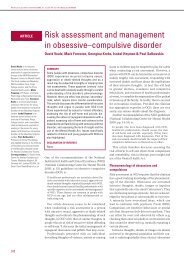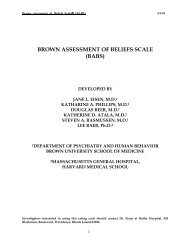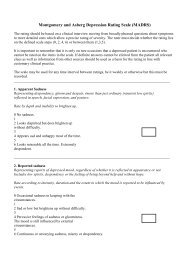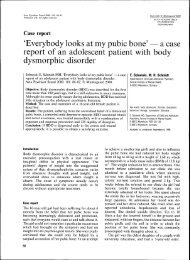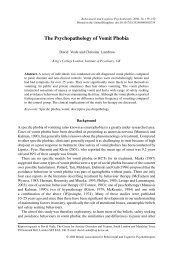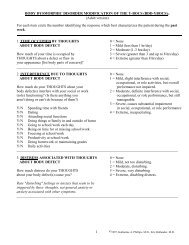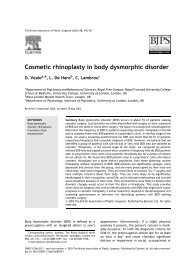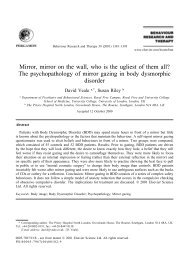Treatment of social phobia - Dr David Veale
Treatment of social phobia - Dr David Veale
Treatment of social phobia - Dr David Veale
You also want an ePaper? Increase the reach of your titles
YUMPU automatically turns print PDFs into web optimized ePapers that Google loves.
<strong>Veale</strong> Advances in Psychiatric <strong>Treatment</strong> (2003), vol. 9, 258–264<strong>Treatment</strong> <strong>of</strong> <strong>social</strong> <strong>phobia</strong><strong>David</strong> <strong>Veale</strong>AbstractSocial <strong>phobia</strong> (or <strong>social</strong> anxiety disorder) manifests as a marked and persistent fear <strong>of</strong> negativeevaluation in <strong>social</strong> or performance situations.The epidemiology, diagnosis and psychopathology arereviewed, including clinical presentation, cultural aspects and the differences between agora<strong>phobia</strong>and <strong>social</strong> <strong>phobia</strong>. Behavioural treatments, including graded self-exposure and cognitive restructuring,are considered. A cognitive model <strong>of</strong> the maintenance <strong>of</strong> <strong>social</strong> <strong>phobia</strong> is discussed. It is hypothesisedthat attentional shifting towards imagery, safety behaviours and ‘post-mortem’ analyses play a keyrole in symptom maintenance. The implications <strong>of</strong> this for treatment are described, and guidelines forpharmacological treatment are summarised.Social <strong>phobia</strong> (or <strong>social</strong> anxiety disorder) consists<strong>of</strong> a marked and persistent fear <strong>of</strong> <strong>social</strong> orperformance situations. Affected individuals fearthat they will be evaluated negatively or that theywill act in a humiliating or embarrassing way.Exposure to <strong>social</strong> or performance situationsinvariably leads to panic or marked anxiety, andsuch situations therefore tend to be avoided orendured with extreme distress.Social <strong>phobia</strong> is the third most common mentaldisorder in adults worldwide, with a lifetimeprevalence <strong>of</strong> at least 5% (depending on thethreshold for distress and impairment). There isan equal gender ratio in treatment settings, butin catchment area surveys, there is a female preponderance<strong>of</strong> 3:2. Individuals are more likely tobe unmarried and have a lower socio-economicstatus. Although common, <strong>social</strong> <strong>phobia</strong> is <strong>of</strong>ten notdiagnosed or effectively treated. There have,however, been a number <strong>of</strong> developments in ourunderstanding and treatment <strong>of</strong> <strong>social</strong> <strong>phobia</strong> overthe past decade, and these are the focus <strong>of</strong> thisarticle.PresentationThe onset <strong>of</strong> <strong>social</strong> <strong>phobia</strong> usually takes placeduring adolescence, although a minority <strong>of</strong> causesinvolve a late onset after a significant life event (suchas an episode <strong>of</strong> failure). The typical course ischronic and life-long. Predisposing factors includea shy or anxious temperament from childhood. Thereis significant comorbidity, especially <strong>of</strong> depression,alcohol or substance misuse or body dysmorphicdisorder. In body dysmorphic disorder, patients are<strong>of</strong>ten too ashamed to reveal their preoccupation withtheir appearance, and present with symptoms <strong>of</strong><strong>social</strong> anxiety and depression, fearing that themental health pr<strong>of</strong>essional will view them as vainor narcissistic. A similar situation exists in patientswith olfactory reference syndrome, who believethat they have body odour that others will findunpleasant, which they may camouflage withperfume. Therefore, all patients with symptoms <strong>of</strong><strong>social</strong> anxiety should be routinely asked whetherthey are very concerned about some aspect <strong>of</strong> theirappearance or about body odour. It should beemphasised that patients with <strong>social</strong> <strong>phobia</strong> do notlack <strong>social</strong> skills. Most affected individuals will havenormal <strong>social</strong> skills in a consultation with you, orwith a friend or partner. In <strong>social</strong> situations, theyare trying too hard and can appear to lack <strong>social</strong>skills, because they might interact less, keep theirhead down or not reveal personal information.Patients (for example, those with Asperger syndrome)who do lack communication skills have adifferent problem.The presentation <strong>of</strong> <strong>social</strong> <strong>phobia</strong> can depend oncultural contexts. In Western cultures, patients mightpresent to surgeons for cures for complaints <strong>of</strong>excessive blushing or sweating. In Japan, <strong>social</strong><strong>phobia</strong> is manifested as an extreme fear <strong>of</strong> bringing<strong>of</strong>fence to others, and is referred to as taijin ky<strong>of</strong>usho.Sufferers <strong>of</strong> this disorder may fear that makingeye contact, blushing, imagined defects in theirappearance or their body odour would be <strong>of</strong>fensiveto others.<strong>David</strong> <strong>Veale</strong> is an honorary senior lecturer at the Royal Free and University College Medical School and a consultant psychiatristat the Priory Hospital (The Bourne, Southgate, London N14 6RA, UK). He has a special interest in cognitive–behaviouraltherapy and its application to anxiety disorders and body dysmorphic disorder.258 Advances in Psychiatric <strong>Treatment</strong> (2003), vol. 9. http://apt.rcpsych.org/
<strong>Treatment</strong> <strong>of</strong> <strong>social</strong> <strong>phobia</strong>PsychopathologyThe core psychopathology in <strong>social</strong> <strong>phobia</strong> is a fear<strong>of</strong> negative evaluation in <strong>social</strong> and performancesituations. It overlaps with the concept <strong>of</strong> shame,although the two sets <strong>of</strong> literature have largelyignored one other (Gilbert & Andrews, 1998). Socialanxiety is best described as the fear <strong>of</strong> feelingashamed (e.g. <strong>of</strong> the emotions aroused and theirinterference in one’s presentation) or the fear <strong>of</strong> beingshamed (e.g. by the negative evaluation <strong>of</strong> oneselfand potential loss <strong>of</strong> rank), or both.Social <strong>phobia</strong> usually leads to avoidance <strong>of</strong>situations such as public speaking or talking to agroup, parties, meetings, eating or drinking inpublic, working or writing while being observed,telephone calls, intimacy or dating. Groups arenearly always more anxiety-provoking than is anindividual. Peers <strong>of</strong> the same age are usually moreanxiety-provoking than older individuals. Forheterosexual individuals, people <strong>of</strong> the oppositegender are usually more anxiety-provoking thanthose <strong>of</strong> the same gender. Sometimes individuals inauthority, especially at work, are more anxietyprovokingthan individuals at the same level.There tend to be two sub-types <strong>of</strong> <strong>social</strong> <strong>phobia</strong> –generalised and non-generalised. Generalised <strong>social</strong><strong>phobia</strong> is more disabling and involves a more diverserange <strong>of</strong> feared stimuli. Those affected by it includesome patients with avoidant personality disorderand it has a worse prognosis. Non-generalised<strong>social</strong> <strong>phobia</strong> is associated with avoidance <strong>of</strong> alimited range <strong>of</strong> performance situations or interactions(such as public speaking), and this overlapswith performance anxiety in sexual dysfunction.Non-generalised <strong>social</strong> <strong>phobia</strong> is easier to treat, witha better prognosis.A person afraid <strong>of</strong> speaking in public would notreceive a diagnosis <strong>of</strong> <strong>social</strong> <strong>phobia</strong> if publicspeaking was not routinely encountered and theperson was not particularly distressed about it. It isusually the degree <strong>of</strong> distress or impairment thatwarrants a diagnosis <strong>of</strong> <strong>social</strong> <strong>phobia</strong>, and thepossible indicators need to be considered in theappropriate context. For example, transient or mild<strong>social</strong> anxiety is especially common in adolescence.The degree <strong>of</strong> severity in <strong>social</strong> <strong>phobia</strong> is veryvariable, ranging from individuals who are virtuallyhousebound and have never had a relationship, toothers who are highly functioning except in certainareas such as making a presentation, which theyfind very distressing and which handicaps them intheir occupation.Social <strong>phobia</strong> might be confused with agora<strong>phobia</strong>.Individuals with agora<strong>phobia</strong> tend tobe female and to be anxious about their physicalor mental health. They misinterpret physicalsensations as evidence <strong>of</strong> an immediate catastropheto their health. Panic attacks in agora<strong>phobia</strong> tend tobe both situational and spontaneous. Affectedindividuals are concerned with a wider range <strong>of</strong>autonomic sensations such as palpitations andfeeling dizzy or short <strong>of</strong> breath. Those with <strong>social</strong><strong>phobia</strong>, however, are more likely to be concernedwith autonomic sensations <strong>of</strong> blushing, shaking orstammering (which the person believes may benoticeable to others). Panic attacks in <strong>social</strong> <strong>phobia</strong>occur almost exclusively in <strong>social</strong> situations. Sometimes,a patient with agora<strong>phobia</strong> also has comorbidsymptoms <strong>of</strong> <strong>social</strong> anxiety. For example, he mightbelieve that he will collapse or go mad as a result <strong>of</strong>a panic attack, but in a <strong>social</strong> situation, he mightalso fear causing a scene and others evaluating himnegatively. Typical beliefs in an individual with<strong>social</strong> <strong>phobia</strong> focus on the perceived negativeevaluation by others <strong>of</strong> revealing a flaw or unacceptablebehaviour (for example, the personbelieves that her hands will shake or she will soundstupid or boring). This is also referred to in theliterature as ‘external shame’.Such individuals tend to have high standards orrules about how they must perform in <strong>social</strong>situations. Their assumption is that failing toachieve these standards might lead others to seethem as inferior, flawed or inadequate and they themselvesalso agree with this assessment (referred toas ‘internal shame’). They predict that this failurewill lead to rejection or a further failure to achievean important goal. Individuals with no internalshame may know that others are rejecting them andview them as inferior, but not believe it aboutthemselves.The emotions in <strong>social</strong> <strong>phobia</strong> are predominantlythose <strong>of</strong> anxiety and shame, and sometimes selfdisgustor anger (which will depend on beliefs andsafety behaviours). As in other anxiety disorders,the main coping (or defensive) behaviour is to escapefrom the situation. There is a strong urge not to beseen. Eye gaze is commonly averted and there isbehavioural inhibition (discussed in more detailbelow under ‘safety behaviours’). These behavioursmight be linked to the submissive defensivebehaviours used to reduce aggression in anotherperson in response to the threat <strong>of</strong> rejection.When the focus is on another person as being badand doing something to expose the individual asinferior, then the main emotion is <strong>of</strong> humiliation(rather than <strong>social</strong> anxiety). There is a sense <strong>of</strong>injustice and unfairness, <strong>of</strong>ten leading to anger anda strong desire for revenge against the one who isexposing the self as weak or inferior.Alcohol and other substances are commonly usedin <strong>social</strong> <strong>phobia</strong>, but such usage might result in aself-fulfilling prophecy as patients may indeed makeAdvances in Psychiatric <strong>Treatment</strong> (2003), vol. 9. http://apt.rcpsych.org/259
<strong>Treatment</strong> <strong>of</strong> <strong>social</strong> <strong>phobia</strong>Modifying post-interaction ruminationsThose affected by <strong>social</strong> <strong>phobia</strong> <strong>of</strong>ten engage in ‘postmortems’.Here, the therapist helps the patient toidentify the content <strong>of</strong> the event (not the feelings)and review what actually happened by shifting toexternal processing and constructing an alternativedata log <strong>of</strong> information that is normally disregardedor distorted.Therapy would normally take between 8 and 20out-patient sessions, depending on the severity andchronicity <strong>of</strong> the <strong>phobia</strong>. Patients with very severe<strong>phobia</strong>, who are housebound or dependent onalcohol, might do better on an intensive programme<strong>of</strong> CBT as either day-patients or in-patients in theright setting.PharmacotherapyMedication is indicated if it is the patient’s firstchoice, CBT has failed, there is a long waiting-listfor CBT or there is significant comorbidity <strong>of</strong>depression. The treatment <strong>of</strong> choice in <strong>social</strong> <strong>phobia</strong>is a selective serotonin reuptake inhibitor (SSRI)(Ballenger et al, 1998). Of the SSRIs, only paroxetineis licensed and marketed in the UK for <strong>social</strong> <strong>phobia</strong>,although there is no reason why other SSRIs maynot be as effective. Most affected individuals cantolerate a normal starting dose <strong>of</strong> an SSRI, as theydo not usually experience an ‘activation syndrome’(as in panic disorder). The starting dose is used for2–4 weeks and then increased as necessary. Theonset <strong>of</strong> action is usually within 6 weeks and anadequate trial period is 8 weeks. The full responsemay occur after up to 12 weeks.About 50% <strong>of</strong> patients relapse on discontinuation<strong>of</strong> an SSRI and treatment is therefore continued for aminimum <strong>of</strong> 12 months. Once in remission, the dosemay be reduced slowly (e.g. a 25% reduction every2 months). If a patient fails to respond to an SSRI,then some evidence exists for the efficacy <strong>of</strong> a monoamineoxidase inhibitor (MAOI) (e.g. phenelzine,45– 90 mg daily) or a reversible monoamine oxidaseinhibitor (RIMA) (e.g. moclobemide, 300–900 mgdaily). Allow 2 weeks between discontinuing anSSRI (5 weeks if fluoxetine) and commencing anMAOI or RIMA. Although there are no evidencebasedguidelines on the treatment <strong>of</strong> patients whohave failed to respond fully to an SSRI or an MAOI,expert opinions suggest the adjunctive use <strong>of</strong> betablockers(e.g. propranolol, starting dose 20 mg daily,gradually increased to 60 mg, or atenolol 50–100 mgdaily) to augment the response. Similarly, clonidinemay augment the response for symptoms <strong>of</strong> blushingwhen used as an adjunct to an SSRI. The use <strong>of</strong>benzodiazepines (especially short-acting ones) isnot recommended, because side-effects at a higherdose can include sedation, forgetfulness, impairedconcentration and disinhibition, especially whenused intermittently. Benzodiazepines are especiallycontraindicated for patients with comorbidity <strong>of</strong>depression and/or a history <strong>of</strong> alcohol or substancemisuse.Which treatment for whom?Only one trial has compared later versions <strong>of</strong> CBTwith an SSRI (Clark et al, 2003), and it found CBT tobe superior to fluoxetine. No trials have yet comparedlater versions <strong>of</strong> CBT with a combination <strong>of</strong>CBT and another SSRI, especially in the long termand after discontinuation <strong>of</strong> the active treatment.As always, treatment will depend upon patientchoice and availability <strong>of</strong> therapy, but in commonwith other anxiety disorders, CBT is the initial choice<strong>of</strong> treatment for <strong>social</strong> <strong>phobia</strong>, as it is usually moreacceptable and has a reduced risk <strong>of</strong> relapse. Asalways, the main problem is user choice and accessto CBT in a timely manner.ReferencesArntz, A. & Weertman, A. (1999) <strong>Treatment</strong> <strong>of</strong> childhoodmemories: theory and practice. Behaviour Research Therapy,37, 715–740.Ballenger, J. C., <strong>David</strong>son, R. T., Lecrubier, Y., et al (1998)Consensus statement on <strong>social</strong> anxiety disorder from theInternational Consensus Group on Depression andAnxiety. Journal <strong>of</strong> Clinical Psychiatry, 59, 54–60.Bogels, S. M., Mulkens, S. & De Jong, P. J. (1997) Taskconcentration training and fear <strong>of</strong> blushing. ClinicalPsychology and Psychotherapy, 4, 251–258.Clark, D. M. (2001) A cognitive perspective on <strong>social</strong> <strong>phobia</strong>.In International Handbook <strong>of</strong> Social Anxiety: Concepts, Researchand Interventions Relating to the Self and Shyness (eds W. R.Crozier & L. E. Alden). pp. 405–430. Chichester: JohnWiley & Sons.––– & Wells, A. (1995) A cognitive model <strong>of</strong> <strong>social</strong> <strong>phobia</strong>. InSocial Phobia – Diagnosis, Assessment, and <strong>Treatment</strong> (eds R.G. Heimberg, M. R. Liebowitz, D. Hope, et al), pp. 69–93.New York: Guilford.–––, Ehlers, A., Hackmann, A., et al (2003) Cognitive therapyvs. fluoxetine plus self exposure in the treatment <strong>of</strong>generalized <strong>social</strong> <strong>phobia</strong> (<strong>social</strong> anxiety disorder): Arandomised placebo controlled trial. Journal <strong>of</strong> Consultingand Clinical Psychology, in press.Connor, K. M., <strong>David</strong>son, J. R. T., Churchill, L. E., et al (2000)Psychometric properties <strong>of</strong> the Social Phobia Inventory(SPIN). British Journal <strong>of</strong> Psychiatry, 176, 379–386.<strong>David</strong>son, J. R. T., Potts, N. L. S., Richichi, E. A., et al (1991)The Brief Social Phobia Scale. Journal <strong>of</strong> Clinical Psychiatry,52, 48–51.Gilbert, P & Andrews, B. (1998) Shame: Interpersonal Behaviour,Psychopathology, and Culture. New York: Oxford UniversityPress.Hackmann, A., Clark, D. M. & McManus, F. (2000) Recurrentimages and early memories in <strong>social</strong> <strong>phobia</strong>. BehaviourResearch and Therapy, 38, 601–610.Heimberg, R. G, Dodge, C. S., Hope, D. A., et al (1990)Cognitive behavioral group treatment for <strong>social</strong> <strong>phobia</strong>:Comparison with a credible placebo control. CognitiveTherapy and Research, 14, 1–23.Liebowitz, M. R. (2002) Social <strong>phobia</strong>. Modern Problems inPharmacopsychiatry, 22, 141–173.Advances in Psychiatric <strong>Treatment</strong> (2003), vol. 9. http://apt.rcpsych.org/263



